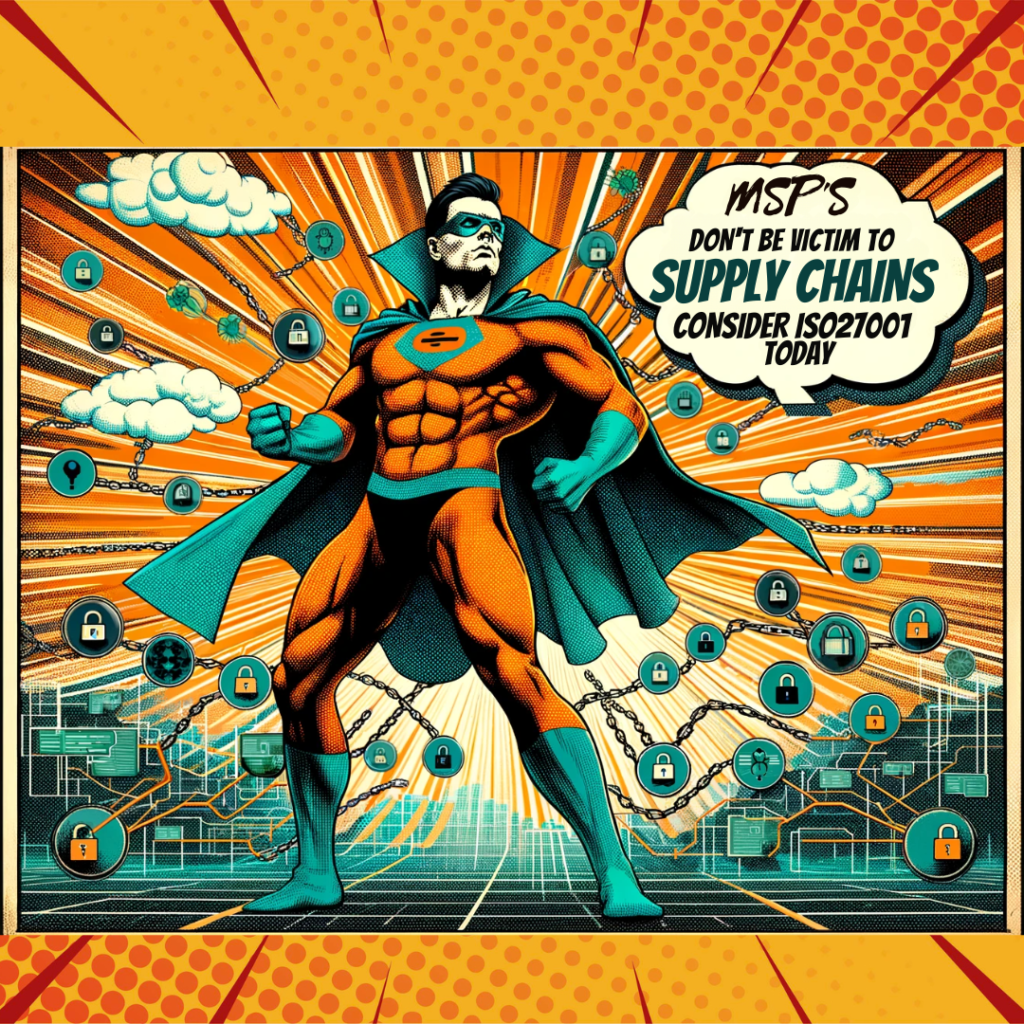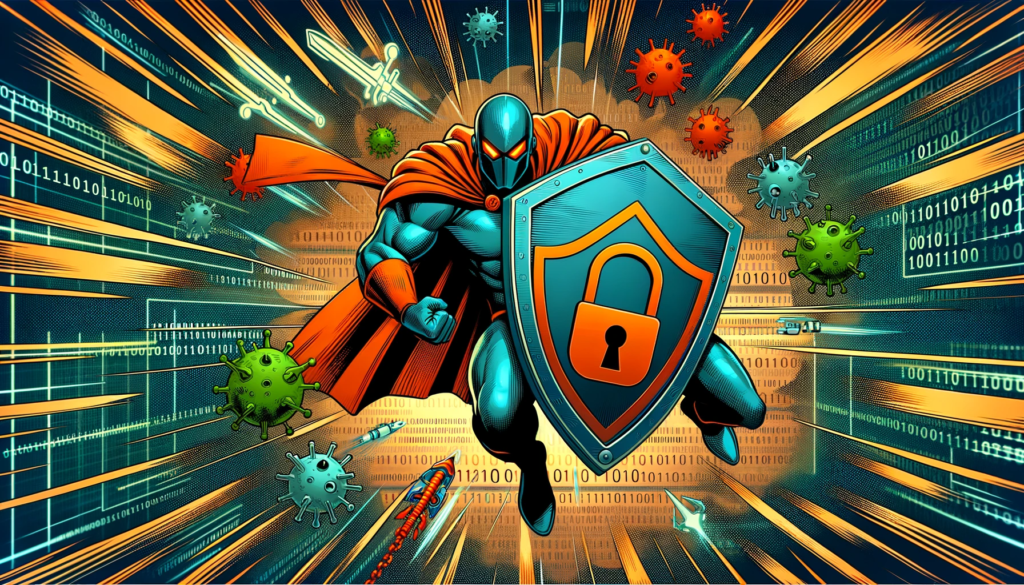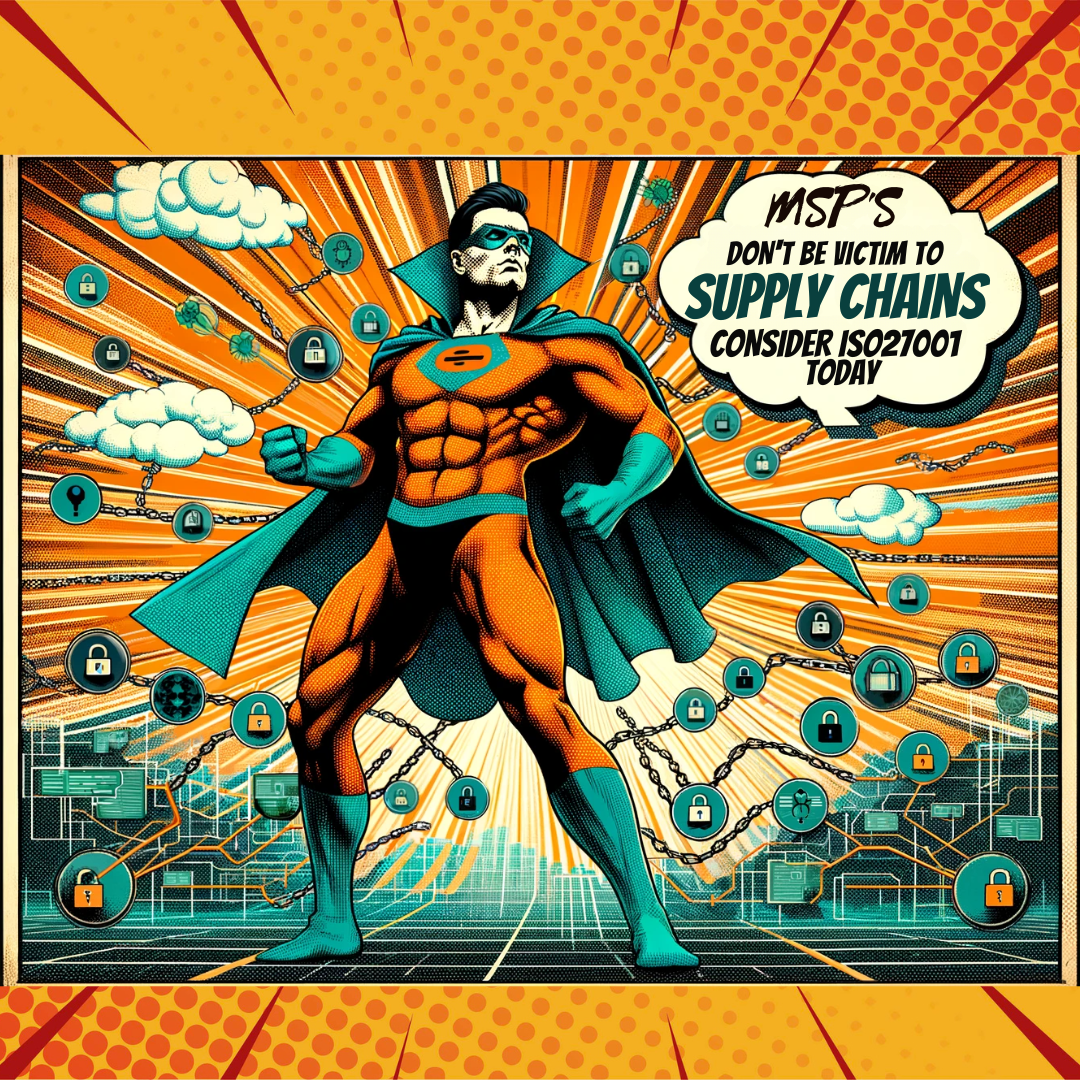The increasing number of cyber threats has brought attention to the vulnerability of managed service providers (MSPs) to supply chain attacks. This poses a significant challenge for MSPs as they not only need to protect their own infrastructure but also that of their customers. In response to this pressing issue, many MSPs are considering ISO 27001:2022, a comprehensive information security standard developed to help businesses manage information security risks and protect sensitive data.

ISO 27001:2022 offers a systematic approach to mitigating the risks posed by supply chain attacks, focusing on the full lifecycle of information security, from risk identification and assessment to implementing preventive measures and continuous improvement. By embracing this standard, MSPs can effectively manage their ICT supply chains and establish a robust, resilient information security infrastructure that guards both their customers and their own businesses.
Key Takeaways
-
- MSPs face challenges in protecting both their own and their customers’ infrastructures from supply chain attacks.
- ISO 27001:2022 provides a comprehensive framework for MSPs to manage information security risks effectively.
- Adhering to ISO 27001:2022 enables MSPs to establish a robust and resilient information security infrastructure.
Understanding MSP and ISO 27001:2022

Managed Service Providers (MSPs) play a crucial role in the information security landscape. With cyber threats becoming more sophisticated, it is essential for MSPs to adopt robust security measures. ISO 27001:2022 is a leading international standard for information security management systems (ISMS) and can help MSPs strengthen their security posture and protect their clients.
The Role of MSP in Information Security
An MSP provides technology and information security services to organisations, helping them manage and prevent cyber threats. They work closely with clients to identify potential risks, develop comprehensive security strategies, and proactively monitor and respond to security incidents. By outsourcing their information security to an MSP, organisations can focus on their core business operations with the confidence that their data and systems are protected.
MSPs need to ensure they adhere to industry best practices and demonstrate their commitment to information security. This is where ISO 27001:2022 comes into play.
Overview of ISO 27001:2022
ISO 27001:2022 is the latest revision of the internationally recognised information security standard. It provides a framework for establishing, implementing, and maintaining an ISMS that helps organisations manage risks, safeguard sensitive information, and comply with data protection regulations. Key updates in ISO 27001:2022 include:
-
- Reduction of controls and domains
- Addition of new controls
- Restructuring of the control framework
MSPs adopting ISO 27001:2022 can demonstrate their commitment to information security to clients, partners, and regulators. By implementing the standard’s requirements, MSPs can effectively manage risks, enhance their security posture, and protect their supply chain.
For MSPs to remain competitive and provide peace of mind to their clients, it is essential to keep up with the evolving information security landscape. ISO 27001:2022 supports MSPs in securing their information assets and ensuring they can prevent, detect, and respond to cyber threats effectively.
Facing Supply Chain Attacks

In the context of managed service providers (MSPs), supply chain attacks have become increasingly prevalent and pose a significant risk to businesses. Implementing ISO 27001:2022 can help organisations protect themselves against such threats. This section will discuss the potential threats and vulnerabilities of supply chain attacks, as well as their impact and consequences.
Potential Threats and Vulnerabilities
Supply chain attacks typically target third-party suppliers who offer vital services or software to the supply chain. The aim of these attacks is to gain access to sensitive environments, steal sensitive data, or gain remote control over systems source. MSPs are particularly vulnerable, as their management tools such as PSA or RMM can be exploited by cybercriminals source.
Some common threats and vulnerabilities include:
-
- Compromised software updates: Attackers can exploit vulnerabilities in software updates to inject malicious code.
- Third-party access: Unsecure access points provided to third-party suppliers can be exploited by attackers.
- Weak security practices: Inadequate security controls or poor encryption practices increase the risk of supply chain attacks.
Impact and Consequences of Attacks
The consequences of supply chain attacks can be far-reaching and severe. Organisations that fall victim to such attacks can suffer significant financial losses and reputational damage, as well as potential regulatory consequences. Moreover, these attacks can disrupt business operations and damage relationships with customers and partners.
Some potential impacts include:
-
- Data breaches: Sensitive customer and business data can be compromised, leading to loss of trust and potential legal repercussions.
- Business disruption: The attack may cause systems to malfunction or become inoperable, interrupting critical operations.
- Financial loss: The costs of remediation, potential fines, and lost business can be substantial.
Implementing preventative measures such as ISO 27001:2022 can help mitigate the risk of supply chain attacks and ensure the protection of vital business assets. By focusing on setting up robust security controls, MSPs can prevent, detect, and respond to such attacks more effectively, minimising their impact on the organisation.
ISO 27001:2022 as a Shield

Utilising the ISO 27001:2022 standard for information security management can be an effective way for managed services providers (MSPs) to protect against the increasing threat of supply chain attacks. This section will focus on two key aspects of the standard that can help mitigate risks: Risk Assessment and Management, and ISO Policies and Controls Implementation.
Risk Assessment and Management
A crucial component of the ISO 27001:2022 standard is its focus on risk assessment and management. By conducting a thorough risk assessment, MSPs can identify potential vulnerabilities within their organisation, as well as those of their service providers.
Once these risks have been identified, MSPs must develop risk management strategies that address each vulnerability. ISO 27001:2022 provides guidance on creating a comprehensive risk management plan, which should include the following elements:
-
- Risk identification: Evaluating assets, threats, and vulnerabilities within the organisation and its supply chain.
- Risk analysis: Assessing the likelihood and impact of each identified risk.
- Risk treatment: Selecting appropriate controls and countermeasures for reducing risks to an acceptable level.
- Monitoring and review: Continually reviewing and updating the risk management plan to account for changes in the threat landscape.
ISO Policies and Controls Implementation
The ISO 27001:2022 standard includes specific policies and controls that organisations must implement to strengthen their information security posture. These controls are divided into four sections, down from the previous 14 sections, and have been reduced from 114 to 93 controls.
Implementing these controls allows MSPs to:
-
- Establish a robust information security management system (ISMS)
- Ensure compliance with relevant legal and regulatory requirements
- Monitor and improve the effectiveness of their ISMS over time
By adhering to the risk assessment process and implementing the appropriate ISO 27001 controls, MSPs can reduce their exposure to supply chain attacks, protect valuable information assets, and maintain a strong reputation within the industry.
Operationalising Security Measures

Inventorying and Managing Assets
Effective asset management is vital in protecting MSPs from supply chain attacks. It involves systematically inventorying assets, classifying them based on criticality, and applying appropriate security measures. An organised and well-maintained inventory of hardware, software, and data enables MSPs to identify potential vulnerabilities and monitor their overall security posture better.
To realise robust asset management, MSPs can follow these best practices:
-
- Create and maintain an asset inventory list
- Group assets based on their criticality and importance
- Regularly review and update the inventory
- Implement continuous monitoring of assets to detect abnormalities
- Establish incident response protocols
Managing Supplier Relationships
Managing supplier relationships is a crucial aspect of mitigating supply chain risks. MSPs should understand their dependencies on third-party vendors and subcontractors and ensure that these suppliers adhere to the same security standards.
MSPs can take the following steps to strengthen supplier relationships:
-
- Vet third-party vendors for their security posture and practices
- Include explicit security requirements in contracts and service level agreements
- Monitor the performance and compliance of suppliers regularly
- Establish clear communication channels and incident response procedures with suppliers
- Perform periodic security audits and risk assessments of third-party suppliers
Insuring Secure Communications
Implementing secure communications is essential for maintaining the confidentiality, integrity, and availability of information. MSPs should adopt communication security measures, such as encryption and authentication, across different channels, including email, file transfers, and messaging systems.
To enhance communication security, MSPs can employ the following techniques:
-
- Encrypt sensitive data transmitted over networks
- Use strong authentication mechanisms, such as two-factor authentication, for accessing systems and services
- Educate employees on the importance of secure communication practices
- Implement secure email gateways and encrypted messaging platforms
- Regularly assess and update communication security policies
By operationalising these security measures, MSPs can mitigate the risks associated with supply chain attacks and establish a more secure, resilient, and reliable service ecosystem. Adopting the recommendations of ISO27001:2022 can further strengthen MSPs’ information security management practices, providing additional protection against emergent cyber threats.
The Continuous Improvement Cycle
Monitoring Security Events
In the realm of cybersecurity, understanding and mitigating potential threats is crucial to ensuring a well-rounded security posture. In the context of Managed Service Providers (MSPs), the importance of monitoring security events is heightened due to the potential risks associated with supply chain attacks.
Security events encompass various incidents such as actual attacks, suspicious activities, access anomalies, and system vulnerabilities. Proactive monitoring of these events helps MSPs detect and respond to threats in a timely manner. Employing advanced tools and technologies, such as Security Information Event Management (SIEM) systems, can support efficient incident detection and analysis.
Through continuous security event monitoring, MSPs can develop a deeper understanding of their environment, identify trends, and keep abreast of emerging risks. Establishing a collaborative approach with their customers and engaging in information sharing on incidents, threats, and best practices can further strengthen the security posture of both parties.
Implementing Corrective Actions
The detection of security events is only a part of the equation when it comes to fortifying an MSP’s cybersecurity. Implementing corrective actions in response to such events plays a significant role in the continuous improvement cycle.
When a security event is detected, MSPs should perform a thorough analysis to determine the root cause of the issue. This analysis helps to identify weaknesses in their systems and processes, as well as areas where additional controls may be needed.
Once the root cause has been established, MSPs should develop and execute a plan to resolve the issue and prevent future occurrences. This may involve implementing new processes, updating policies, or deploying additional security measures. Corrective actions should be documented and communicated to all relevant stakeholders, including customers when necessary.
As a part of the ongoing improvement process, MSPs should evaluate the effectiveness of implemented corrective actions by monitoring their impacts on the security environment. Regular audits and reviews can facilitate this assessment, ensuring that the corrective measures are having the desired positive effects.
By embracing the continuous improvement cycle and focusing on both monitoring security events and implementing corrective actions, MSPs can strengthen their security posture and better safeguard themselves and their customers from supply chain attacks.
Frequently Asked Questions
What measures can organisations implement to prevent supply chain attacks?
Organisations can implement several measures to prevent supply chain attacks. First, ensure that all connections between internal systems, customer systems, and other networks are reviewed and verified. Segregating customer data sets and services from each other and internal company networks can also limit the impact of a single attack vector1. Regularly updating software, monitoring for unusual activities, educating employees on cybersecurity best practices, and conducting regular audits can collectively strengthen an organisation’s defenses against supply chain attacks.
How does ISO27001:2022 help in protection against supply chain threats?
ISO27001:2022 is an international standard for information security management systems (ISMS). Implementing ISO27001:2022 can help organisations to establish, maintain, and improve information security. The standard includes various security controls specifically designed to address supply chain threats. By following ISO27001:2022, organisations can assess and manage risks, achieve compliance with legal and regulatory requirements, and demonstrate commitment to information security to their customers and partners.
What are the major risks associated with supply chain attacks in MSPs?
In MSPs, supply chain attacks can lead to significant consequences, such as loss or theft of sensitive data, disruption of services or software, and damage to an organisation’s reputation2. Supply chain attackers often target trusted third-party suppliers to gain access to sensitive environments, making it difficult for MSPs to detect and prevent the attack. These attacks can also spread beyond the initially targeted organisation, affecting other organisations connected to the MSP’s supply chain.
What is the role of ACSC in identifying and mitigating cyber threats?
The Australian Cyber Security Centre (ACSC) is responsible for providing advice, guidance, and assistance to organisations on how to protect against cyber threats3. ACSC works to identify and mitigate cyber threats by sharing information with stakeholders, conducting threat assessments, and advising on best practices and procedures. Additionally, ACSC provides alerts and advisories to raise awareness of current and emerging threats, helping organisations stay informed and prepared for potential attacks.
How can adopting ISO27001:2022 improve an MSP’s cybersecurity posture?
Adopting ISO27001:2022 can improve an MSP’s cybersecurity posture through a systematic approach to managing sensitive information and protecting it from unauthorised access and disclosure. By implementing ISO27001:2022, MSPs can demonstrate their commitment to information security, improve risk management capabilities, and enhance their reputation as a trusted, secure service provider4. The standard also helps MSPs to comply with legal and regulatory requirements, increasing customer confidence in the organisation’s information security practices.
What are the key takeaways from the 2023 Cybersecurity Report for MSPs?
The 2023 Cybersecurity Report for MSPs highlights the increasing prevalence of supply chain attacks and the importance of implementing strong security measures. Key takeaways include the need for MSPs to maintain up-to-date software, educate employees on cyber threats, and establish partnerships with trusted third-party suppliers5. The report also underscores the benefits of adopting ISO27001:2022 as a comprehensive framework for achieving a robust cybersecurity posture that can effectively counter supply chain threats.
Footnotes
- https://www.cyber.gov.au/about-us/advisories/protecting-against-cyber-threats-managed-service-providers-and-their-customers ↩
- https://www.datto.com/resources/an-msp-guide-to-reducing-the-risk-of-a-supply-chain-attack ↩
- https://www.cyber.gov.au/about-us ↩
- https://www.iso.org/isoiec-27001-information-security.html ↩
- https://www.computerweekly.com/microscope/opinion/How-can-MSPs-minimise-the-risk-of-supply-chain-attacks ↩

